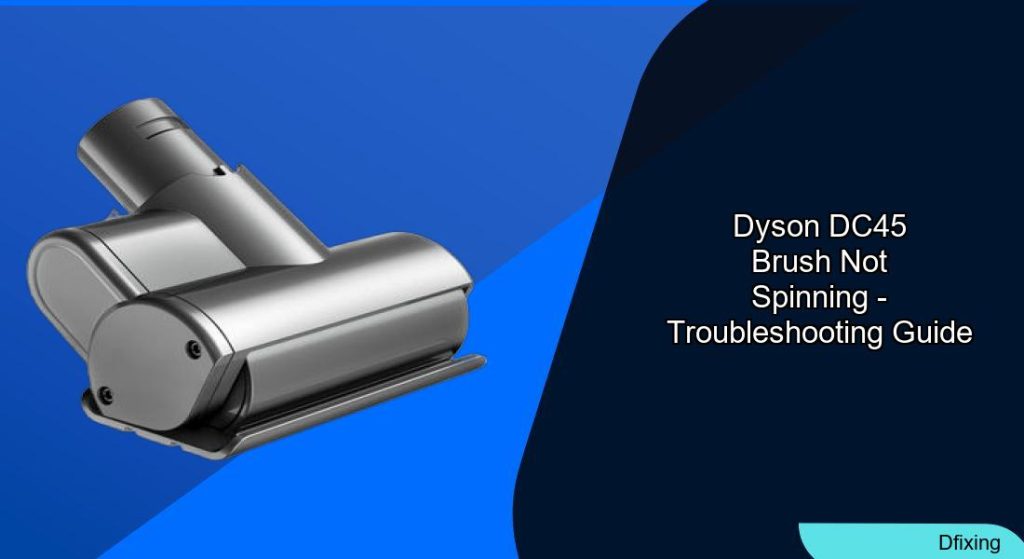The Dyson DC45’s brush bar plays a critical role in capturing debris, but when it stops spinning, cleaning efficiency plummets. Issues like blockages, worn components, or electrical malfunctions can disrupt performance. This guide breaks down the root causes, provides step-by-step repair instructions, and shares preventative strategies to keep your vacuum running smoothly. Whether you’re troubleshooting a jammed brush bar or seeking long-term solutions, this article covers everything you need to know.
Affiliate disclosure: As an Amazon associate, We'll earn a commission for every successful order through our affiliate links in the article. However, you won’t be charged anything for this.
Most brush bar problems stem from preventable issues like hair or debris buildup, but electrical faults or mechanical wear can also be culprits. While DIY fixes often resolve minor glitches, knowing when to replace parts or contact Dyson support ensures your vacuum stays reliable. Let’s dive into the common causes and solutions to get your DC45 back in action.
Common Causes of Brush Bar Problems
Blockages: The Usual Suspect
Hair, threads, and small objects like coins frequently around the brush bar, halting its rotation. Over time, debris accumulates in the bearings or gears, creating friction that stalls the mechanism. Regular inspection and cleaning are essential to prevent these obstructions.
Worn-Out Components: A Hidden Culprit
Frayed bristles, damaged bearings, or a snapped belt can all lead to brush bar failure. The belt, which transfers power from the motor to the brush bar, often wears out after prolonged use. If the brush bar spins unevenly or feels loose, internal parts like gears or bearings may need replacement.
Electrical Issues: When Power Fails
Faulty wiring, a malfunctioning motor, or a damaged circuit board can cut power to the brush bar. A humming sound without rotation often indicates a motor issue, while intermittent operation might point to loose connections or a defective switch.
Step-by-Step Troubleshooting and Repairs
Safety First: Prepare for Maintenance
Always unplug the vacuum and empty the dust bin before starting repairs. Gather tools: screwdrivers (flathead, Phillips, Torx T10), scissors, cleaning cloths, and replacement parts if needed.
Clearing Blockages: A Quick Win
- Inspect the Brush Bar: Remove the cleaner head using the release button. Check for tangled hair or debris and cut it away with scissors.
- Manual Rotation Test: Spin the brush bar by hand. If it resists movement, disassemble further to clear internal buildup.
Testing the Motor and Circuit Board
- Check Power Supply: Ensure the vacuum is charged and the outlet functions. Listen for unusual noises when powering on.
- Inspect Wiring: Secure loose connections on the circuit board and look for burn marks or damaged components. Use fine sandpaper to clean corroded connectors.
Replacing the Belt: A Cost-Effective Fix
- Remove the Old Belt: Slide it off the motor pulley and brush bar.
- Install a New Belt: Loop it around the pulley and brush bar, ensuring proper tension. Reassemble and test for smooth rotation.
Inspecting the Brush Bar Switch
Locate the switch near the bottom plate. If it doesn’t click when pressed, replace it to restore functionality.
Preventative Maintenance Tips
Regular Cleaning: Small Efforts, Big Results
Weekly checks for debris and monthly deep cleans prevent buildup. Use a Torx T10 screwdriver to disassemble the brush bar housing and clear trapped hair. Lubricate bearings with WD-40 for smooth operation.
Proper Storage: Protect Your Investment
Store the vacuum upright in a dry area to avoid moisture damage. Avoid extreme temperatures to prolong component lifespan.
Use the Right Settings: Avoid Overloading
Adjust the brush bar height based on flooring type. Using the “Carpet” setting on hard floors strains the motor and accelerates wear.
When to Seek Professional Help
Signs of Bigger Issues
Persistent motor noise, frequent breakdowns, or burning smells indicate deeper problems. At this stage, DIY repairs risk further damage.
Contacting Dyson Support
For complex electrical faults or warranty-covered repairs, reach out to Dyson’s customer service or visit an authorized service center.
User Insights and Alternative Solutions
Some users report mixed experiences with Dyson support, opting instead for third-party brush heads on platforms like eBay. While these are cheaper, verify compatibility to avoid recurring issues. For cordless models like the V6, cleaning the filter by twisting off the top and washing the sock-like component improves airflow and motor longevity.
FAQs
Why won’t my Dyson DC45’s brush bar spin?
Common causes include blockages, a broken belt, or electrical faults. Start by clearing debris and testing the motor.
How often should I clean the brush bar?
Inspect weekly and perform a deep clean every few months, especially if you have pets.
Can I replace the brush bar belt myself?
Yes. Purchase a compatible belt, remove the old one, and ensure proper alignment during installation.
What if the motor hums but doesn’t spin the brush bar?
A humming sound often signals a faulty motor or circuit board. Check wiring and consider professional repair.
How do I reset the brush bar switch?
Toggle the switch five times while the bar is extended. Ensure the vacuum’s power button is pressed during this process.
Conclusion
A non-spinning Dyson DC45 brush bar is a common but solvable issue. By addressing blockages, replacing worn parts, and practicing regular maintenance, you can extend your vacuum’s lifespan. For persistent problems, Dyson support or authorized technicians offer reliable solutions. Whether you choose DIY fixes or professional help, keeping your DC45’s brush bar in top shape ensures consistent cleaning performance. Remember: proactive care saves time, money, and frustration in the long run.







